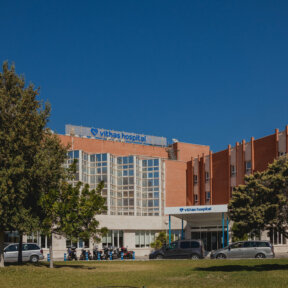What is rheumatology?
Rheumatology is the medical speciality concerned with preventing, diagnosing and treating non-surgical and autoimmune musculoskeletal diseases (connective diseases).
There are more than 200 rheumatic diseases and they can affect any age range, from children to the elderly. Taken together, these conditions affect one in four adults in Spain.
They are the second reason for visits to the doctor in primary care — after acute respiratory infections — and a leading cause of disability.
Musculoskeletal diseases affect bones, muscles and joints, as well as the surrounding tissues, and can cause pain, inflammation, stiffness, movement limitation and deformities.
These diseases, together with connective diseases, are usually chronic, so they need to be monitored by a rheumatologist throughout life.
Which patients is it for?
A rheumatologist can address any conditions that affect the bones, muscles or joints. The most common reason to see a rheumatologist is pain, located somewhere in the locomotor system, although swelling, joint deformities or limited mobility are other symptoms you may need to seek help for.
Rheumatology includes a wide range of diseases that can be classified into several groups:
- ARTHRITIS: The term arthritis refers to a direct disorder of the joints that causes swelling, pain and loss of mobility. They can be transient or chronic. Arthritis can be a disease as such, like rheumatoid arthritis, gout, ankylosing spondylitis, psoriatic arthritis, juvenile idiopathic arthritis, and other spondyloarthropathies. It can also be a symptom of other rheumatic diseases, as in the case of systemic lupus erythematosus.
- OSTEOARTHRITIS: In this group of diseases, the initial damage settles in the articular cartilage, which progressively degenerates and causes joint pain, deformities and loss of mobility. Osteoarthritis may be primary (the most common and with no known cause) or secondary, caused by another disease.
- LUMBAR PAIN: In most cases, it is difficult to determine the cause of lumbar pain, but sometimes it may be caused by a herniated disc, a narrow lumbar canal or static abnormalities of the spine.
- OSTEOPOROSIS AND PRIMARY BONE DISEASES: Osteoporosis is a disease that weakens bones, causing them to fracture. It is a veritable epidemic in the western world due to the progressive ageing of the population.
- SOFT TISSUE RHEUMATISM: Comprises diseases of the tendons (tendonitis), bursae (bursitis), muscles (myopathies), and even the peripheral nervous system, such as nerve entrapment syndromes.
- AUTOIMMUNE AND SYSTEMIC DISEASES: Encompasses a set of diseases involving an alteration of the immune system: the body produces antibodies (autoantibodies) against itself, in other words, the immune system attacks healthy tissue by mistake. These diseases are called systemic, because they generally affect different organs and systems (skin, lung, kidneys, heart, eyes, etc.). Examples include systemic sclerosis (also called scleroderma), systemic lupus erythematosus, Sjögren’s syndrome, polymyositis, dermatomyositis and mixed connective tissue disease.
- VASCULITIS: Vasculitis is a group of conditions that cause inflammation of blood vessels (arteries, arterioles, veins, capillaries). This inflammation can also be triggered by the presence of autoantibodies. Rheumatic polymyalgia is the most prevalent disease in this group.
Main diagnostic resources and technology
- Radiography
- Computed tomography (CT) scan
- Magnetic resonance imaging (MRI)
- Joint and musculoskeletal ultrasound
- Capillaroscopy
- Arthroscopy
- Bone densitometry
- Clinical analyses
- Biopsy
Main treatments
- Analgesics and anti-inflammatory drugs
- Infiltrations
- Physical therapy and rehabilitation
- Corticosteroids
- Disease-modifying drugs
- Biological drugs
Areas of specialisation
Today, advancements in systemic musculoskeletal and autoimmune diseases have led to the superspecialisation and creation of monographic clinics within the field of rheumatology, such as those for metabolic bone diseases, connective diseases, back pain or early arthritis diagnosis.
FAQs
Dismantling myths
“If your bones hurt, it’s probably rheumatism.” False. Rheumatism as such does not exist, and in reality there are more than 200 different rheumatic diseases that can affect specific areas of the body.
“Only old people get rheumatic diseases.” False. You can get them at any age, in fact, the diseases included in the group of juvenile idiopathic arthritis affect one in every 1,000 children, while rheumatoid arthritis is more common in women who are around 40 years old.
“All systemic autoimmune diseases are rare diseases.” It is true that when studied individually, with the exception of rheumatoid arthritis and Sjögren’s syndrome, they are rare. However, according to the American Autoimmune Related Diseases Association (AARDA), as a whole they affect about 50 million people worldwide.
“They’re inevitable diseases, they cannot be prevented.” Some rheumatic diseases, such as osteoporosis and gout, can be prevented by leading a healthy lifestyle. For example, exercising strengthens muscles and promotes mobility. Not smoking is also beneficial in these cases, as it has been scientifically proven that tobacco worsens inflammatory rheumatic diseases and promotes the onset of rheumatoid arthritis and osteoporosis.
“The cold is worse for people with rheumatic diseases.” While it’s true that changes in atmospheric pressure caused by weather changes can affect the joints and cause you to feel more pain, this is not due to the cold. In fact, people all over the world get rheumatic diseases, regardless of climate.















